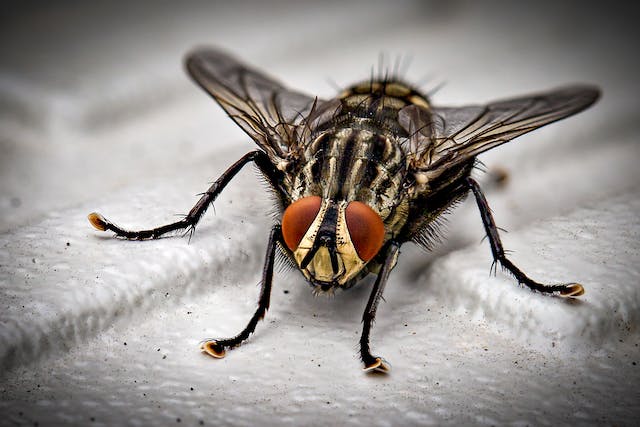
How do flies perceive time? Flies see the world in slow motion, possibly seeing things four times slower than we do.
We have probably all tried to swat a fly sitting on a table. You swing your hand towards it, you impact the table and you’re sure you got it, only to see the fly safely flying away from you. How could it move out of the way so quickly? It turns out that flies process information far more quickly than we do, giving them the ability to see in slow motion. They see things four times more slowly than we do, so the hand coming towards them was moving very slowly and they had ample time to get out of its way.
It isn’t just flies that have this ability. Time is obviously subjective and the way an animal perceives it is very dependent on its size. Generally, small animals perceive time much more quickly than larger animals do. This is to do with their metabolic rate, the speed with which their neurons can recharge, and whether or not they need the ability to see things quickly. The animals that perceive time the fastest are usually small and either fly or live in the ocean. Flying animals have to be able to see faster to avoid objects, make sudden turns, and to avoid predators. Fish have to be able to see changes quickly because both predators and prey are able to move suddenly. On land, once a lion pounces on a gazelle, it cannot adjust its position because it is in the air. Both the lion and the gazelle don’t need to have fast vision because of this. In the ocean, when a shark darts at a fish, it is still in the water and it can adjust its position of attack at any point, meaning that both the shark and the fish it is attacking need to be able to perceive changes in the environment more quickly.
The first question is how can researchers work out the speed at which an animal perceives time? They use something called the flicker test. Animals are exposed to a flickering light that gradually gets faster and faster. The researchers monitor the light receptors in the animal’s retina and when the animal sees the flickering light as a continuous image, that is the speed at which they perceive time. For example, humans can see a light flickering at up to 65 flashes per second, which means we can perceive changes in our environment at a rate of 65 changes a second. Dragonflies, on the other hand, can detect 300 flashes per second, which means they can perceive changes 5 times faster than we can. The average fly can perceive about 250 flashes per second, 4 times faster than we can. Starfish can only see one flash every 1.3 seconds, so most of their life is a blur. Pied fly catchers can see 146 flashes a second and dogs can see 75 flashes a second. That means, if you are watching TV with your dog, they can see the gap between each image that is flashing on the screen.
How do flies see so quickly? They have five techniques. The first technique is the number of lenses they have in their compound eyes. They have 3,000 individual lenses that give them a 360 degree field of vision. They can take in more visual information than we can. The second technique is that they sacrifice clarity for speed. Our eyes and brains need high resolution images because we need to be able to spot camouflaged predators and prey against varying backgrounds. Flies sacrifice this detail for fast processing. Their 3,000 lenses take in more information, but they are unable to focus on a single object. They get more of a general image than we do. The third thing is the amount of their brains that is devoted to vision. They have a far larger percentage of their brain that only deals with visual signals. The fourth technique is that their brain processes the information and has to do less with it than our brains do. We have evolved fairly complex brains that overanalyze information. A fly doesn’t do this. When the brain receives visual stimulus, it is able to react very quickly. And the fifth technique is the way the photoreceptor cells in the eyes work. In our eyes, light waves are converted to an electrical signal through a chemical reaction. It takes time to reset the neuron and the photoreceptor cell to receive the next signal. This slows down the speed with which we can see. The photoreceptor cells in a fly’s eye appear to be triggered physically. When the cell is exposed to light, it contracts, creating the electrical signal. This manual contraction can happen much faster than a chemical reaction and it can be reset almost instantly. All of these reasons are why it is so hard to swat a fly. And this is what I learned today.
Photo by Thierry Fillieul: https://www.pexels.com/photo/macro-photo-of-black-fly-1046492/
Sources
https://www.sciencedaily.com/releases/2022/12/221220113053.htm
https://www.theguardian.com/science/2013/sep/16/time-passes-slowly-flies-study
https://phys.org/news/2012-10-eye-mystery-insight-flies-fastest.html
https://www.mpg.de/research/fly-brain-decoding-motion-detection
https://www.kuow.org/stories/why-it-s-so-hard-to-swat-a-fly
https://www.mpg.de/20374809/fruit-fly-s-complex-symphony-of-vision
